The Enterpise TLC Storage Era Begins: Rounding Up 13 SSDs With Samsung, Intel, and Memblaze
by Billy Tallis on January 3, 2019 9:45 AM ESTPeak Throughput And Steady State
For client/consumer SSDs we primarily focus on low queue depth performance for its relevance to interactive workloads. Server workloads are often intense enough to keep a pile of drives busy, to the maximum attainable throughput of enterprise SSDs is actually important. But it usually isn't a good idea to focus solely on throughput while ignoring latency, because somewhere down the line there's always an end user waiting for the server to respond.
In order to characterize the maximum throughput an SSD can reach, we need to test at a range of queue depths. Different drives will reach their full speed at different queue depths, and increasing the queue depth beyond that saturation point may be slightly detrimental to performance, and will drastically and unnecessarily increase latency. SATA drives can only have 32 pending commands in their queue, and any attempt to benchmark at higher queue depths will just result in commands sitting in the operating system's queues before being issued to the drive. On the other hand, some high-end NVMe SSDs need queue depths well beyond 32 to reach full speed.
Because of the above, we are not going to compare drives at a single fixed queue depth. Instead, each drive was tested at a range of queue depths up to the excessively high QD 512. For each drive, the queue depth with the highest performance was identified. Rather than report that value, we're reporting the throughput, latency, and power efficiency for the lowest queue depth that provides at least 95% of the highest obtainable performance. This often yields much more reasonable latency numbers, and is representative of how a reasonable operating system's IO scheduler should behave. (Our tests have to be run with any such scheduler disabled, or we would not get the queue depths we ask for.)
One extra complication is the choice of how to generate a specified queue depth with software. A single thread can issue multiple I/O requests using asynchronous APIs, but this runs into at least one of two problems: if each system call issues one read or write command, then context switch overhead becomes the bottleneck long before a high-end NVMe SSD's abilities are fully taxed. Alternatively, if many operations are batched together for each system call, then the real queue depth will vary significantly and it is harder to get an accurate picture of drive latency.
Using multiple threads to perform IO gets around the limits of single-core software overhead, and brings an extra advantage for NVMe SSDs: the use of multiple queues per drive. The NVMe drives in this review all support 32 separate IO queues, so we can have 32 threads on separate cores independently issuing IO without any need for synchronization or locking between threads. For even higher queue depths, we could use a combination of techniques: one thread per drive queue, issuing multiple IOs with asynchronous APIs. But this is getting into the realm of micro-optimization that most applications will never be properly tuned for, so instead the highest queue depths in these tests are still generated by having N threads issuing synchronous requests one at a time, and it's up to the OS to handle the rest.
Peak Random Read Performance
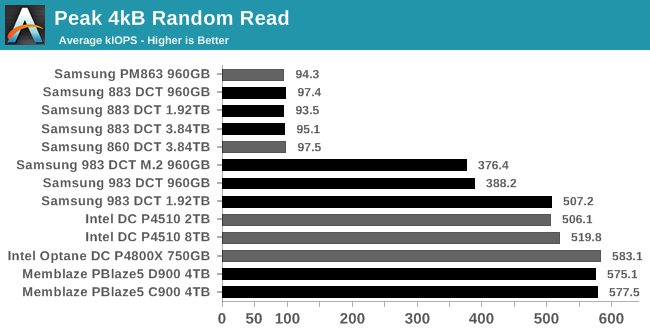
The SATA drives all have no trouble more or less saturating their host interface; they have plenty of flash that could service more read requests if they could actually be delivered to the drive quickly enough. Among NVMe drives, we see some dependence on capacity, with the 960GB Samsung 983 DCT falling well short of the 1.92TB model. The rest of the NVMe drives make it past half a million IOPS before software overhead on the host system becomes a bottleneck, so we don't even get close to seeing the PBlaze5 hit its rated 1M IOPS.
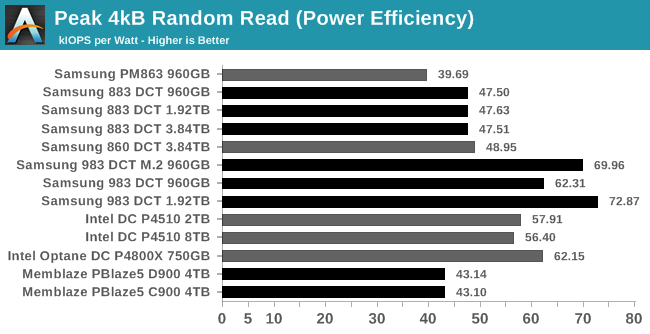 |
|||||||||
| Power Efficiency in kIOPS/W | Average Power in W | ||||||||
The Samsung 983 DCT offers the best power efficiency on this random read test, because the drives with bigger, more power-hungry controllers weren't able to show off their full abilities without hitting bottlenecks elsewhere in the system. The SATA drives offer respectable power efficiency as well, since they are only drawing about 2W to saturate the SATA link.

The 2TB P4510 and both PBlaze5 drives have consistency issues at the 99.99th percentile level, but are fine at the more relaxed 99th percentile threshold. The Optane SSD's latency scores are an order of magnitude better than any of the other NVMe SSDs, and it was the Optane SSD that delivered the highest overall throughput.
Peak Sequential Read Performance
Since this test consists of many threads each performing IO sequentially but without coordination between threads, there's more work for the SSD controller and less opportunity for pre-fetching than there would be with a single thread reading sequentially across the whole drive. The workload as tested bears closer resemblance to a file server streaming to several simultaneous users, rather than resembling a full-disk backup image creation.

The Intel drives don't quite match the performance of the Samsung 983 DCT or the slower PBlaze5. The Optane SSD ends up being the slowest NVMe drive on this test, but it's actually slightly faster than its spec sheet indicates. The Optane SSD's 3D XPoint memory has very low latency, but that doesn't change the fact that the drive's controller only has seven channels to work with. The PBlaze5s are the two fastest drives on this test, but they're both performing significantly below expectations.
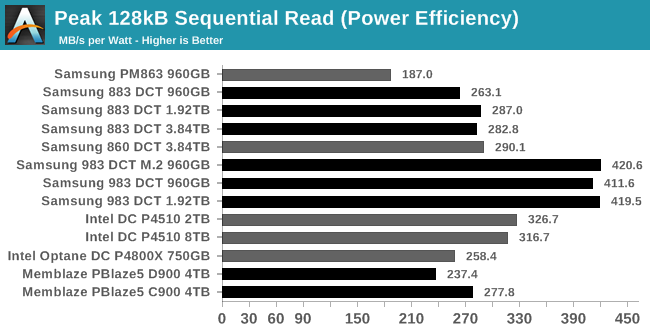 |
|||||||||
| Power Efficiency in MB/s/W | Average Power in W | ||||||||
The Samsung 983 DCT clearly has the lead for power efficiency, followed by the slightly slower and more power-hungry Intel P4510. The current-generation SATA drives from Samsung mostly stay below 2W and end up with decent efficiency scores despite the severe performance bottleneck they have to contend with.
Steady-State Random Write Performance
The hardest task for most enterprise SSDs is to cope with an unending stream of writes. Once all the spare area granted by the high overprovisioning ratios has been used up, the drive has to perform garbage collection while simultaneously continuing to service new write requests, and all while maintaining consistent performance. The next two tests show how the drives hold up after hours of non-stop writes to an already full drive.
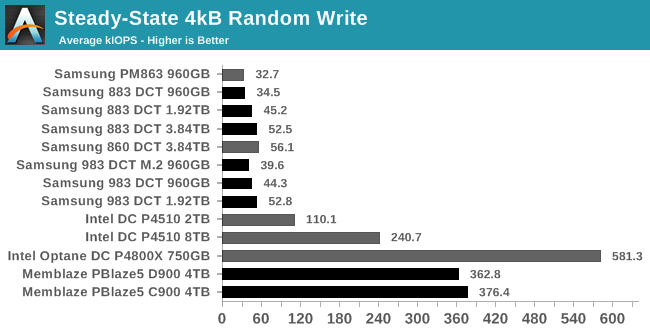
The Samsung drives don't even come close to saturating their host interfaces, but they are performing according to spec for steady-state random writes, with higher-capacity models offering clearly better performance. The Intel and Memblaze drives have a huge advantage, with the slower P4510 maintaining twice the throughput that a 983 DCT can handle.
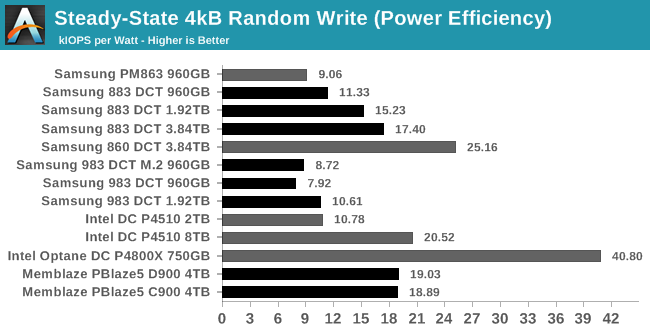 |
|||||||||
| Power Efficiency in kIOPS/W | Average Power in W | ||||||||
The Samsung 983 DCTs used about 1.5W more power to deliver only slightly higher speeds than the Samsung SATA drives, so the NVMe drives wind up with some of the worst power efficiency ratings. The Optane SSD with its wide performance lead more than makes up for its rather high power consumption. In second place for efficiency is the lowly Samsung 860 DCT; despite our best efforts, it continued deliver higher than spec performance results on this test, while drawing less power than the 883 DCT.
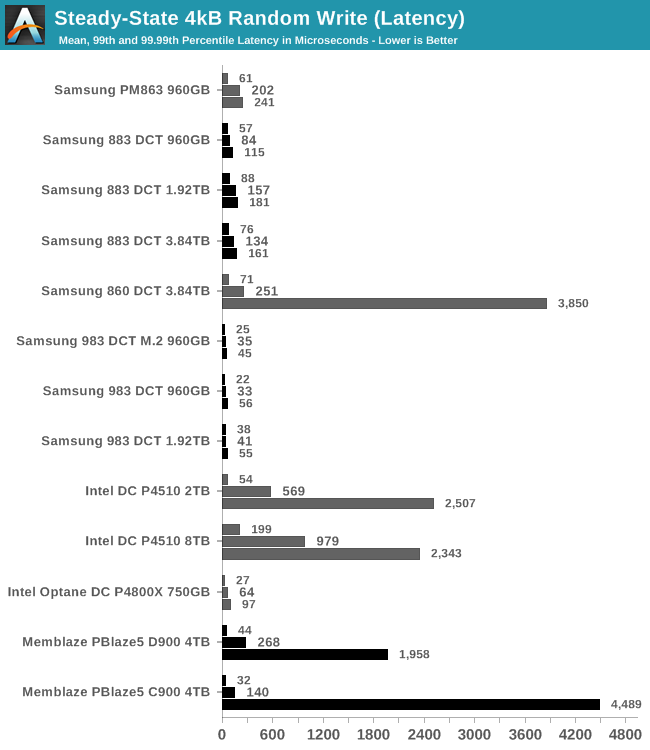
The random write throughput provided by the Samsung 983 DCT at steady-state is nothing special, but it delivers that performance with low latency and extremely good consistency that rivals the Optane SSD. The Intel P4510 and Memblaze PBlaze5 SSDs provide much higher throughput, but with tail latencies that extend into the millisecond range. Samsung's 883 DCT SATA drive also has decent latency behavior that is far better than the 860 DCT.
Steady-State Sequential Write Performance
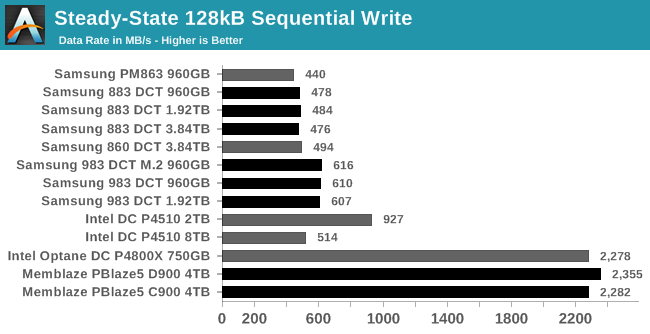
The steady-state sequential write test mostly levels the playing field. Even the NVMe drives rated at or below 1 DWPD offer largely SATA-like write throughput, and only the generously overprovisioned PBlaze5 can keep pace with the Optane SSD.
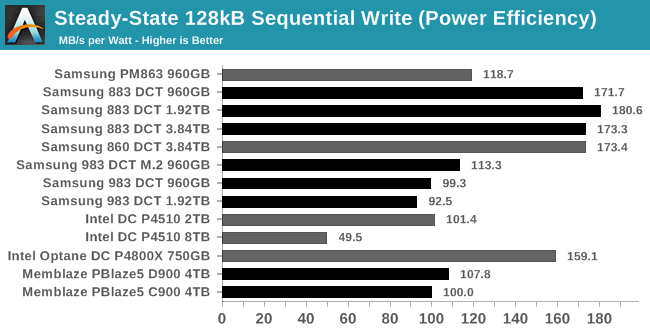 |
|||||||||
| Power Efficiency in MB/s/W | Average Power in W | ||||||||
The PBlaze5 requires over 20W to keep up with what the Optane SSD can deliver at 14W, so despite its high performance the PBlaze5's efficiency is no better than the other NVMe drives. It's the SATA drives that come out well ahead: even though this workload pushes their power consumption relatively high, Samsung's latest generation of SATA drives is still able to keep it under 3W, and that's enough for a clear efficiency win.










36 Comments
View All Comments
Greg100 - Saturday, January 5, 2019 - link
I have to disagree with the last sentence of this quote about Intel SSD DC P4510:“The NAND and DRAM on the inner faces of the two PCBs do not get any airflow or thermal pads bridging them to the case. This lack of cooling is one of the major motivators of Intel's Ruler form factor, now standardized as EDSFF.”
Intel's main motivation was not cooling, but charging an extra fee for the new format:
€ 5051,90 Intel SSD DC P4500 8TB, HHHL
€ 6060,90 Intel SSD DC P4500 8TB, Ruler
(Prices: IC-S Austria)
Proper cooling for inner faces of the two PCBs would be by using AMEC Thermasol Ultra flat Heat pipe (also known as flat aluminium cool pipe) connecting with case.
but hey… it’s Intel, who make incredible space technology, but can not solder i7-8700K CPU!
What the eyes don't see, the heart doesn't grieve over ;-)
Thank you very much Billy for disassemble this SSD.
So… I will have to use Fujipoly Ultra Extreme XR-m thermal pads with huge Fisher Elektronik passive heatsinks outside. Better would be AMEC Thermasol + Fujipoly Ultra Extreme XR-m inside, but I do not want to void of 5 year warranty.
Kristian Vättö - Sunday, January 6, 2019 - link
You won't find real enterprise SSD pricing online because it's strictly B2B business with volume and numerous other factors playing a big role. One SKU may be more expensive just for the fact that the demand is low, so the distributor/reseller is not getting a volume discount. The reseller may also be marking it up due to it being new, unique and simply low volume, warranting a higher margin.Greg100 - Sunday, January 6, 2019 - link
You are right. There are many factors that influence the final price. Indeed, the ruler has its advantages: https://www.anandtech.com/show/11702/intel-introdu...I just wish, Intel will not neglect the cooling of U.2 2.5" drives, just because it has another format.
Greg100 - Sunday, January 6, 2019 - link
And thanks Kristian, that you read comments. I hope you will remember this:Samsung SSD 860 EVO
4TB
550MB/s
520MB/s
625,47 € (Cloudmarkt, Germany)
Intel DC P4510
8TB
3200MB/s (Read)
3000MB/s (Write)
2 300,78 £ (Bleepbox, UK)
so....
2x more expensive per GB than Samsung SSD 860 EVO 4TB
6x faster (sequentially) than Samsung SSD 860 EVO 4TB
Samsung has also fast U.2 7.68TB SSD, but it’s OEM-Product and no support and warranty for end customers.
I would pay 2x price for 6x faster SSD, just like I would pay 2x price for 6x faster CPU. So, why Samsung can not make large, fast SSD availably for consumers?
Please DO NOT LOOK at revenues of Samsung SSD 860 EVO 4TB. PC enthusiasts look for something faster, not obsolete SATA. SATA drives should be for really cheap, huge HDDs using ONLY for backup, not for SSDs.
And please do not tell me about M.2 drives. U.2 SSDs will always have larger capacity and better thermal cooling than M.2. Always. It is so true like desktop PC will always be faster than laptop. Of course you can make really fast laptop, but you can always have 2x or 3x faster desktop PC. Not everyone need larger or faster so laptops and M.2 always be made, but when somebody, like me, looking for best of the best, large and fast U.2 SSDs are only route right now.
Greg100 - Sunday, January 6, 2019 - link
Fortunately every new motherboard has M.2 port (compatible with NVMe and PCI-E 3.0 x4), so we can connect U.2 SSD via U.2 to M.2 cable (Intel J15713-001).I would like to have more motherboards with more number native U.2 ports, that take up much less space than M.2 ports, so we can have many U.2 SSDs mounted in cooler place in desktop PC, just like we have mounted old HDDs.
GCappio - Sunday, October 6, 2019 - link
Just saw a 61.3 TBytes SSD model from Huawei in Rome, Italy during a Huawei Smart City tour, would love to see its performance - but maybe it's not a product you'll see in the USA...